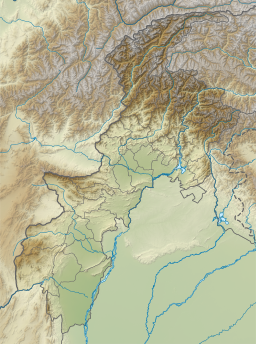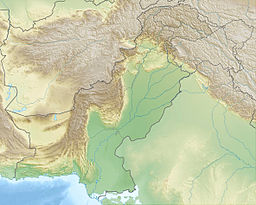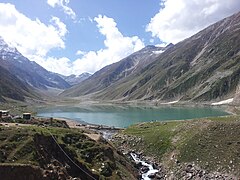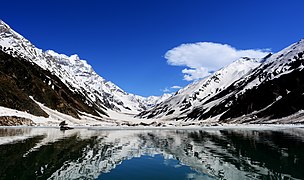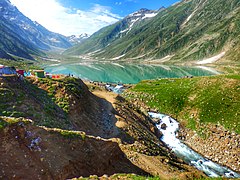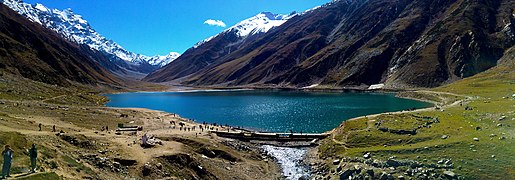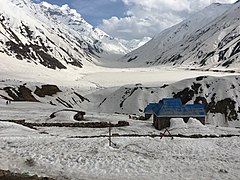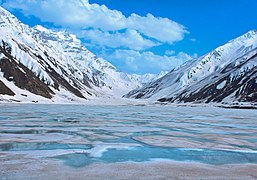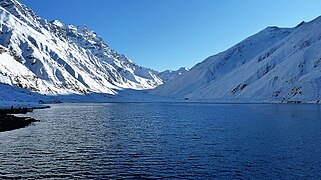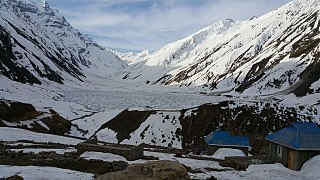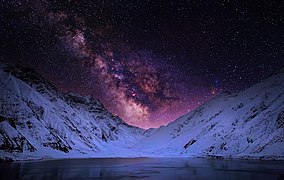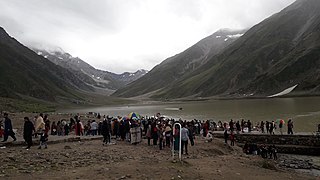Lake Saiful Muluk
| Lake Saiful Muluk | |
|---|---|
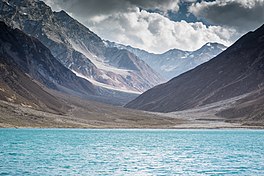 The lake is notable for its picturesque setting in the mountains of northern Pakistan | |
| Location | Saiful Muluk National Park, Kaghan Valley, Khyber Pakhtunkhwa, Pakistan |
| Coordinates | 34°52′37″N 73°41′40″E / 34.876957°N 73.694485°E |
| Lake type | Alpine, glacial lake |
| Primary inflows | Glacial water |
| Primary outflows | Stream (a tributary of Kunhar River) |
| Basin countries | Pakistan |
| Surface area | 2.75 km2 (1.06 sq mi) |
| Max. depth | 113 ft (34 m) |
| Surface elevation | 3,224 metres (10,577 ft)[1] |
| Settlements | Naran |
Saiful Muluk (Urdu: جھیل سیف الملوک) is a mountainous lake in northern Pakistan, located at the northern end of the Kaghan Valley, near the town of Naran in the Saiful Muluk National Park. At an elevation of 3,224 m (10,578 feet) above sea level, the lake is located above the tree line, and is one of the highest lakes in Pakistan.
Location
[edit]
Saiful Muluk is located in the Mansehra district of Khyber Pakhtunkhwa, about 9 kilometres (5.6 mi) north of Naran,[2][3] in the northern part of Kaghan Valley. Malika Parbat, the highest peak in the valley is near the lake.[4]
The lake is accessible from the nearby town of Naran during the summer season but access during winter is limited, as heavy snowfall and landslides threaten to cutoff the lake from other regions.[citation needed]
Physical features
[edit]Saiful Muluk was formed by glacial moraines that blocked the water of the stream passing through the valley.[5] The Kaghan Valley was formed in the greater Pleistocene Period dating back almost 300,000 years when the area was covered with ice. Rising temperatures and receding glaciers left a large depression where glaciers once stood. Melting water collected into the lake.[citation needed]

Ecology
[edit]The lake has rich eco-diversity and holds many species of blue-green algae. Large brown trout are found in the lake, up to about seven kilograms.[6] About 26 species of vascular plant exist in the area, with Asteraceae the most commonly found species. Other species commonly found in the region are: Ranunculaceae, Compositae, Cruciferae, Gramineae, Apiaceae, Leguminosae, Scrophulariaceae and Polygonaceae.[citation needed]
Folklore
[edit]The Lake Saiful Muluk is named after a legendary prince from the tale titled Saiful Muluk, later on put into poem form by the Sufi poet Mian Muhammad Bakhsh.[7] It tells the story of the Egyptian Prince Saiful Malook who fell in love with a fairy princess named Princess Badri-ul-Jamala at the lake.[8][1]
The Story of Prince Saiful Maluk (Arabic: قِصَّة سَيْف الْمُلُوْك وَبَدِيْع الْجَمَال, romanized: Qiṣat Saif al-Mulūk wa Badīʿ al-Jamāl) is an Arabic fable, a story of love between a prince and a fairy. It is considered a later addition to the One Thousand and One Nights collection of Arabic fables. In South Asia, the story was put into Punjabi verse by 19th-century poet and mystic Mian Muhammad Bakhsh. It has also been retold in numerous languages such as Balochi, Bengali, English, Urdu and Punjabi.[9][10][11][12][13]
According to the folklore, Saiful Maluk was a prince of Egypt. He had significant wealth which he had inherited from his forefathers. Inscribed on the treasure were two seals; one bearing the image of Saiful Muluk and the other one being that of Badi-ul-Jamala.[1] One night, Prince Saiful Maluk saw in a dream, a lake and a fairy. He got up and went to tell his dream to his father, asking him about the place and the fairy. His father told him that he can't meet the fairy as she isn't human, unlike him. However, the longer the prince recollected his dream, the more he was overwhelmed with love for the fairy.[14][15]
Gallery
[edit]Hover the mouse click or tap on the following images to see their captions.
-
Lake Saiful Muluk under clouds
-
A view of lake in Wortez
-
Lake Saiful Muluk in a sunny day
-
A full view of Lake Saif-ul-Muluk
-
Lake Saif ul Malook in May 2017
-
The lake freezes over in winter
-
Lake Saif ul Muluk in December 2012
-
Tourist point with Lake
-
A boat in Saiful Maluk Lake
-
Lake Saif-Ul-Mulook, Kaghan Valley, Pakistan
-
Lake Saif-Ul-Mulook at night
-
Lake Saiful Malook Pakistan
See also
[edit]- Lulusar Lake
- Katora Lake
- Dudipatsar Lake
- Mahodand Lake
- Ratti Gali Lake
References
[edit]- ^ a b c Sana Zehra (22 April, 2016). "Saiful Muluk-Prince of Egypt". Daily Times. Retrieved 1 June 2018.
{{cite news}}: CS1 maint: numeric names: authors list (link) - ^ "Distance from Naran". Google Maps. Retrieved 10 June 2018.
- ^ Ali, Ihsan. "Natural Heritage of Kaghan Valley" (PDF). Mapping and Documentation of the Cultural Assets of Kaghan Valley, Mansehra (Report). Islamabad: UNESCO. p. 46. Archived from the original (PDF) on 12 July 2018. Retrieved 20 September 2012.
- ^ Hussain, Manzoor; Khan, Mir Ajab; Shah, Ghulam Mujtaba (5 March 2006). "Traditional Medicinal and Economic uses of Gymnosperms of Kaghan Valley, Pakistan". Ethnobotanical Leaflets. 10: 72. ISSN 1948-3570. Retrieved 20 September 2012.
- ^ Ehlers, J.; Gibbard, P. L. (29 July 2004). Quaternary Glaciations - Extent and Chronology (2 ed.). Elsevier. pp. 305–306. ISBN 978-0444515933. Retrieved 16 September 2012.
- ^ Muhammad Yaqoob (14 March 2003). "Production and culture of trout in the Northwest Frontier Province and Northern Areas of Pakistan, A review". In Peter, T.; Swar, S. B. (eds.). Cold water fisheries in the trans-Himalayan countries. Rome: Food and Agriculture Organization. p. 327. ISBN 978-9251048078. Retrieved 16 September 2012.
- ^ "The News International: Latest News Breaking, Pakistan News". www.thenews.com.pk.
- ^ Javed, Asghar (23 June 2002). "Pristine lakes of the north". Dawn. Archived from the original on 13 July 2007. Retrieved 10 September 2016.
- ^ Shackle, Christopher. “The Story of Sayf Al-Mulūk in South Asia.” Journal of the Royal Asiatic Society 17, no. 2 (2007): 115–29. http://www.jstor.org/stable/25188702.
- ^ Ram Babu Saksena. A history of Urdu literature: with a foreword. R. N. Lal, 1940.
- ^ Amaresh Datta. Encyclopaedia of Indian Literature. Sahitya Akademi, 1987.
- ^ Janet Parker; Alice Mills; Julie Stanton. Mythology: Myths, Legends and Fantasies. Struik, 2007.
- ^ Thomas Grahame Bailey. A history of Urdu literature. Oxford University Press, 2008.
- ^ Lane, Edward Williams (1877). "Story of Seyf-el-Mulook and Bedeeạ-el-Jemál". The thousand and one nights, commonly called, in England, The Arabian nights' entertainments. Vol. III. London: Bickers. pp. 283–342.
- ^ Kincaid, C.A. (1922). Tales of old Sind. London: Oxford University Press. pp. 37–50.

